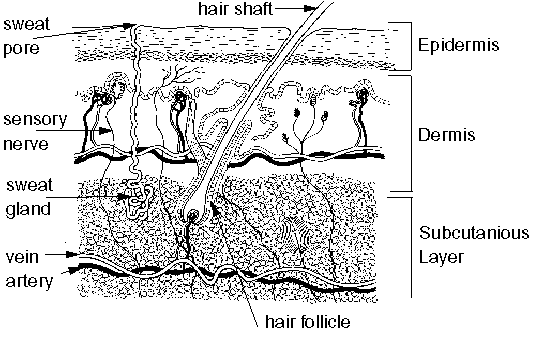Medical Terminology for Cancer
© Copyright 1996-2013
5: The Integumentary System (Skin)
Contents
 Functions of the Integumentary System
Functions of the Integumentary System The Epidermis (thin outer layer of skin)
The Epidermis (thin outer layer of skin) The Dermis (thick inner layer of skin)
The Dermis (thick inner layer of skin) Connective tissue and Membranes
Connective tissue and Membranes Roots, suffixes, and prefixes
Roots, suffixes, and prefixes Cancer Focus
Cancer Focus Related Abbreviations and Acronyms
Related Abbreviations and Acronyms Further Resources
Further ResourcesFunctions of the Integumentary System
This is the skin, and skin derivatives; (hair, nails, glands and receptors). The Integumentary system has many functions:
- Protects the body's internal living tissues and organs
- Protects against invasion by infectious organisms
- Protects the body from dehydration
- Protects the body against abrupt changes in temperature
- Helps dispose of waste materials
- Acts as a receptor for touch, pressure, pain, heat and cold
- Stores water, fat, and vitamin D.

The skin has two main layers, the epidermis and the dermis:
The Epidermis (thin outer layer of skin)
The Epidermis itself is made up of many layers. The basale stratum is the only layer capable of cell division 'pushing up' cells to replenish the outer layer which is constantly shedding dead cells. The Epidermis does not contain blood vessels (non-vascular). It contains the pigment melanin which gives skin colour and allows the skin to tan, uneven distribution of melanin causes 'freckles'.
The protein keratin stiffens epidermal tissue to form finger nails. Nails grow from a thin area called the 'NAIL MATRIX', growth of nails is about 1 mm per week on average. The lUNULA is the crescent shaped area at the base of the nail, this is a lighter colour as it mixes with the matrix cells.
The epidermis.contains different types of cells, the most common are; squamous cells which are flat, scaly cells on the surface of the skin, basal cellswhich are round cells, and melanocytes which give the skin its colour. The epidermis also contains Langerhan's cells, these are formed in the bone marrow and then migrate to the epidermis. They work in conjunction with other cells to fight foreign bodies as part of the body's immune defense system. Granstein cells play a similar role.
The Dermis (thick inner layer of skin)
The dermis consists of blood vessels, connective tissue, nerves, lymph vessels, glands, receptors, hair shafts. The dermis has two layers, the upper papillary and lower reticular layers. The Papillary is the upper layer of the dermis, it has ridges and valleys causing finger prints. It contains receptors which communicate with the Central Nervous System, these include touch, pressure, hot, cold and pain receptors. These are not evenly distributed over the body, for example there are more on the lips and finger tips making them more sensitive. The reticular layer is made of dense elastic fibers (connective tissue), this houses hair follicles, nerves, and certain glands.
The dermis contains several important glands. The sebaceous glands located near the hair follicles secrete oil to keep skin and hair soft and moist. The sudorferous glands secrete sweat to regulate temperature and are located under the dermis with ducts to the surface. The ceruminous glands secrete wax to stop dust entering the ear.
HAIR There is hair on every part of body (except palms and soles), this helps maintain body temperature. Eye lashes filter out harmful particles. Hair grows from follicles that contain the lower shaft and root of the hair. The hair shaft projects through the dermis and epidermis and is kept soft by the sebaceous glands. Hair colour is determined by the concentration of melanin. There are tiny muscles attached to the follicles (arrector pili), when cold or frightened these tighten forming 'goose pimples'.
Anatomy of a skin. Short animation narrated by Dannishi. Source: http://youtu.be/c_IGuPYLsFI
Connective tissue and Membranes
These are not necessarily part of the Integumentary System, and are general to many of the other systems of the body.
Connective tissues support and protect the body's organs, and bind organs together. They usually are highly vascular (rich blood supply) and contain fibres. There are many types of connective tissue, for example loose connective tissue occurs around organs and attaches the skin to the underlying tissues. Dense connective tissues are tougher, for example tendons attach muscles to bones.
Membranes Mucous membranes line a body cavity that opens directly to the exterior, preventing the cavity from drying out e.g. in the mouth. Serous membranes line a body cavity that does not directly open to the outside, and provide lubrication so that organs can move more easily e.g. the pleura is a membrane that lines the thoracic cavity and protects the lungs.
Roots, suffixes, and prefixes
Most medical terms are comprised of a root word plus a suffix (word ending) and/or a prefix (beginning of the word). Here are some examples related to the Integumentary System. For more details see Chapter 4: Understanding the Components of Medical Terminology
| component | meaning | example |
| CUT- | skin | subcutaneous layer = layer below the skin |
| DERMA- | skin | dermatology = study of the skin and its diseases |
| EPI- | upon | epidermis = layer above the dermis |
| LIPO- | fat | lipoatrophy = atrophy of fat below the skin |
| MELAN- | black | melanin = the black pigment in the skin |
| ONYCH- | nail | onychectomy = excision of a nail |
| PACHY- | thick | pachyderma = abnormal thickening of skin |
| SCLERO- | hand / tough | scleroderma = chronic hardening of the skin |
| SUDOR- | sweat | sudorific = an agent that promotes sweat |
| -ITIS | inflammation | dermatitis = inflammation of the skin |
| -OMA | tumour | melanoma = black coloured skin tumour |
| -OSIS | condition / disease | dermatophytosis = a fungal infection of the skin |
Cancer Focus
- Overview of Skin Cancer
- Skin cancer is the most common type of cancer and accounts for half of all new cancers in Western populations. It occurs more often in people with light coloured skin who have had a high exposure to sunlight. The two most frequent types of skin cancer are
Basal Cell Carcinomas and Squamous Cell Carcinoma (often grouped under "non-melanoma skin cancer"). The third most frequent skin cancer is Melanoma, this is a malignancy of the cells which give the skin it's colour (melanocytes). In addition there are a
number of other, less common cancers starting in the skin including Merkel cell tumours, cutaneous lymphomas, and sarcomas (see the pages on sarcoma and lymphoma in this guide).
 Internet Resources for Skin Cancer
Internet Resources for Skin Cancer - Melanoma
- Melanoma is a malignancy of the skin in which melanocytes (the cells which give the skin it's colour) become cancerous. Melanoma occurs most frequently in white people, and is rare in people with dark skin; it is usually found in adults, though
occasionally melanoma may develop in children and adolescents. Over exposure to sunlight can cause skin changes which can lead to melanoma. Half of all melanomas are thought to arise in a benign (non-cancerous) pigmented nevus (a mole). Moles are very
common and normally change only slightly over time; however in melanoma there may be a more rapid increase in size - symptoms include a darker or variable discoloration, itching, and possibly ulceration and bleeding.
 Internet Resources for Melanoma
Internet Resources for Melanoma - Basal Cell Carcinoma (BCC)
- This is where the basal cells become cancerous; basal cells are found in the epidermis (the outermost layer of skin). This is the most common type of skin cancer which is usually highly curable when detected early.
 Internet Resources for Basal Cell Carcinoma
Internet Resources for Basal Cell Carcinoma - Squamous Cell Carcinoma (SCC)
- A type of skin cancer arising in squamous cells (the flat, scaly cells on the
surface of the skin). Cure rates are very hight when detected and treated early.
 Internet Resources for Squamous Cell Carcinoma (skin)
Internet Resources for Squamous Cell Carcinoma (skin) - Merkel cell cancer
- Merkel cell cancer (also known as trabecular cancer, or neuroendocrine cancer of the skin) is a
rare type of malignancy developing on or just beneath the skin. These tumours can develop at any age, but the peak incidence is between ages 60 - 80. They are more frequent in white people, the most common sites of diseases are the face or scalp and other
areas of high sun exposure.
 Internet Resources for Merkel Cell Cancer
Internet Resources for Merkel Cell Cancer
Related Abbreviations and Acronyms
| BCC | Basal Cell Carcinoma |
| LMM | Lentigo Maligna Melanoma |
| MM | Malignant Melanoma |
| NBCCS | Nevoid basal cell carcinoma syndrome |
| NM | Nodular Melanoma |
| NMSC | Non Melanoma Skin Cancer |
| SC | Subcutaneous |
| SCC | Squamous Cell Carcinoma |
| SSM | Superficial Spreading Melanoma |
| UVR | Ultra Violet Radiation |
Further Resources (4 links)
 Integumentary System Overview
Integumentary System Overview
YouTube
Lecture by 'bullharrier'
WebAnatomy, University of Minnesota
Test your anatomy knowledge with these interactive questions. Includes different question types and answers.
University of Pennsylvania Health System
Detailed guide with diagrams, from the ADAM Body Guide.
Rapid Learning Center
Details of the layers and sub-layers of skin.



This guide by Simon Cotterill
First created 4th March 1996
Last modified: 1st February 2014

 CancerIndex
CancerIndex